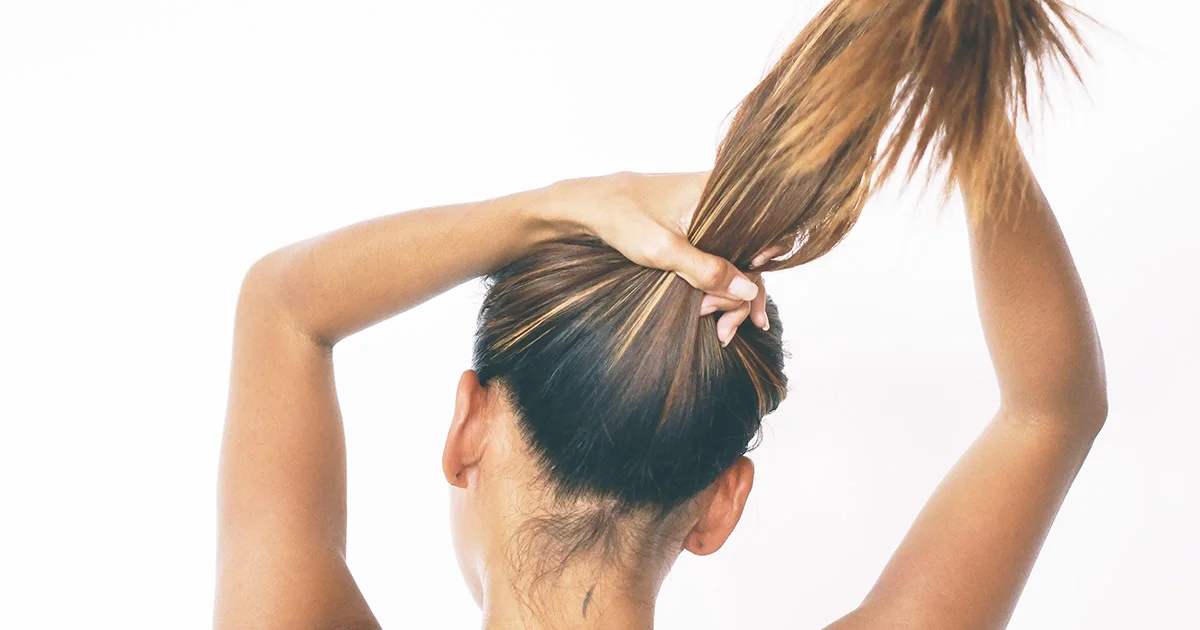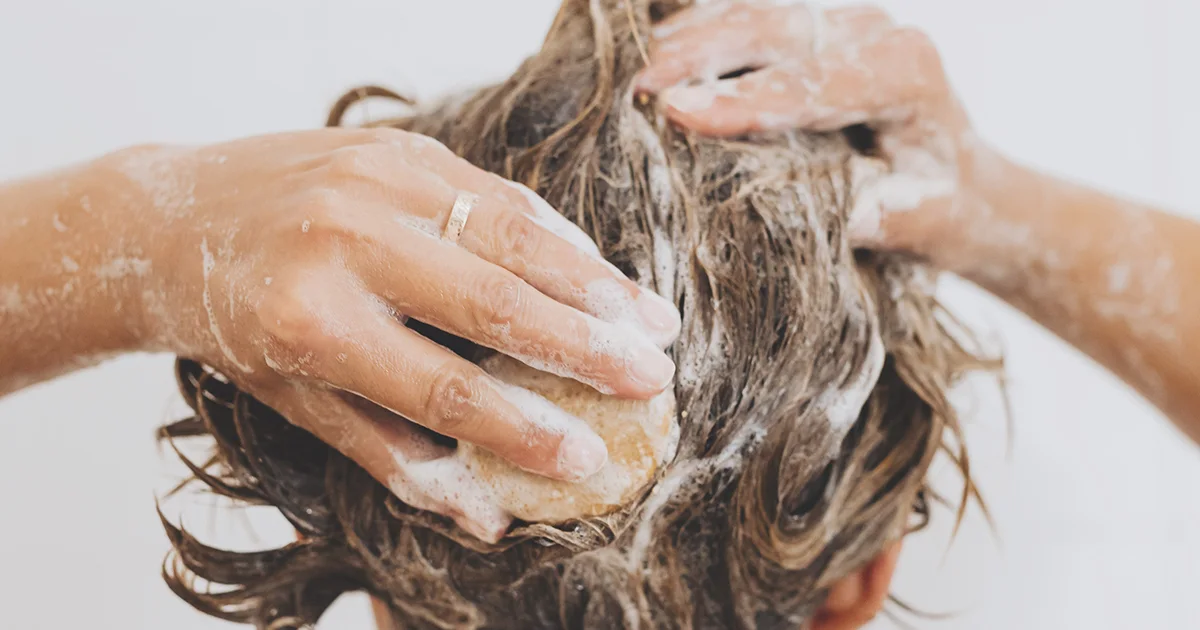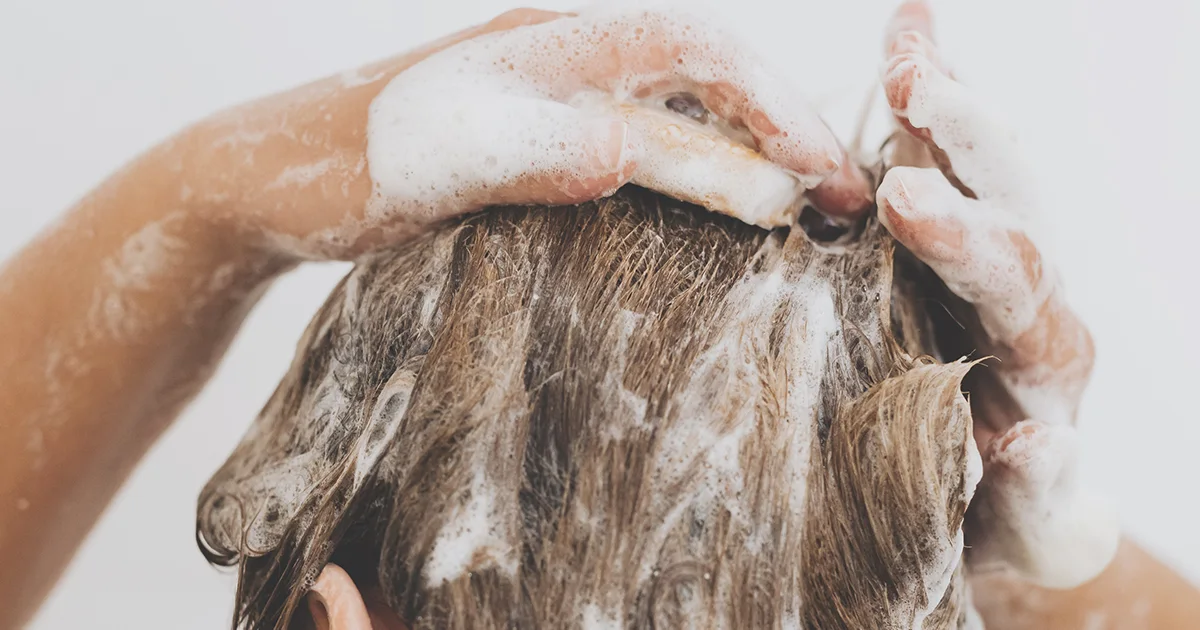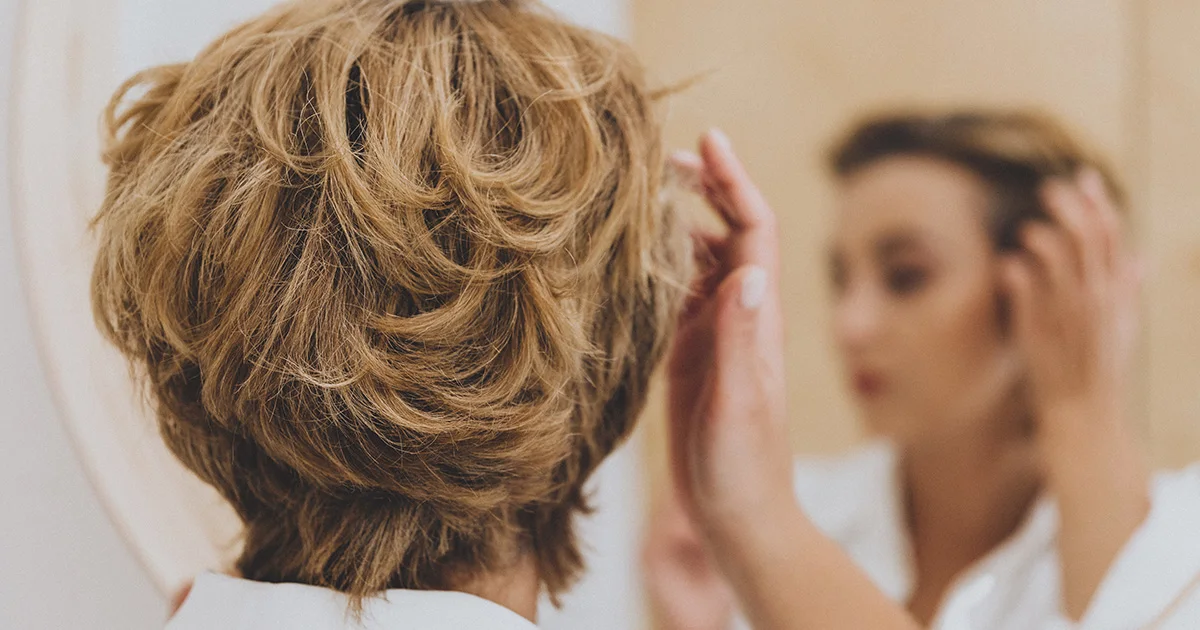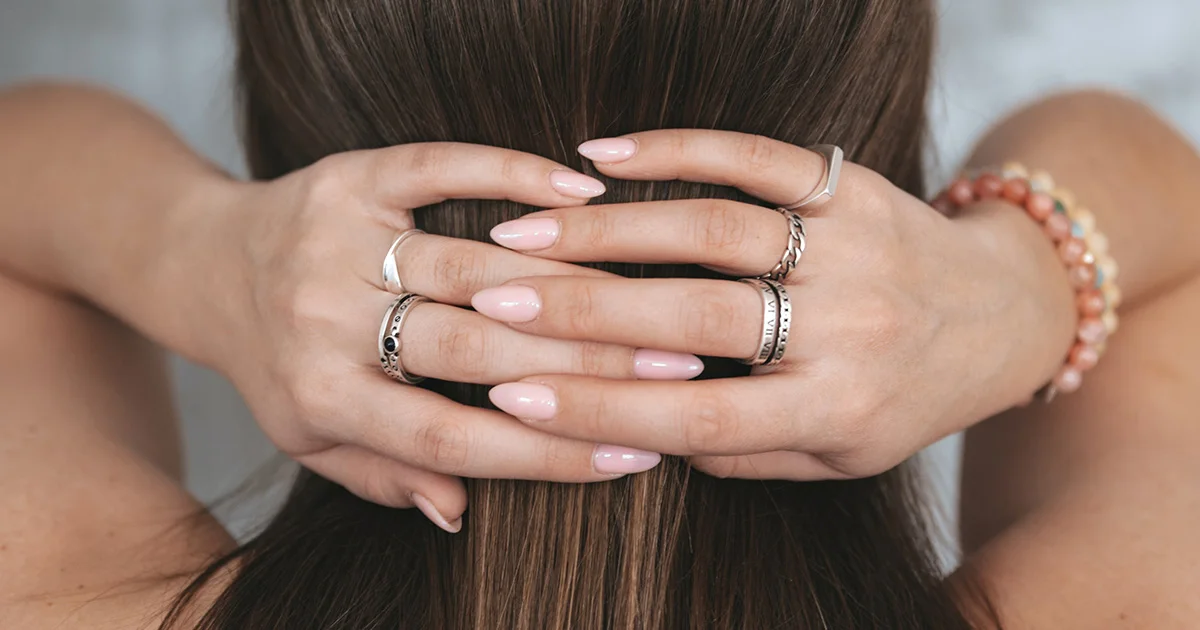Here's what we'll cover
Here's what we'll cover
Whether you’re suffering from a particularly unfortunate haircut or you’re just ready to change your style, you may be eager to grow your hair faster. So, how much does hair grow in a year? You can expect about 6 inches of hair growth each year.
Continue reading to learn more about how hair growth works and what you can do to set yourself up for lustrous success.
How much does hair grow in a year?
Hair grows about ½ inch a month. So, you can expect about six inches of hair growth in a year. Several factors can affect the rate of your hair growth, including genetics and your overall health (Murphrey, 2022).
All of the hairs on your head cycle through the following phases (Hoover, 2022):
Anagen (growth phase): Your hair is actively growing during the anagen phase. This phase can last for several years. So, you have the anagen phase to thank for your hair growth over the course of a year.
Catagen (transition phase): The catagen phase occurs when your hair is ready to stop growing. It lasts for a few weeks and prepares your hair for the telogen phase.
Telogen (resting phase): During the telogen phase, your hair is at rest and does not grow. At one time, around 10–15% of the hairs on your head are in this resting phase. This phase can last for up to one year.

Hair loss and the hair growth cycle
Hair loss can occur when the hair growth cycle is interrupted.
For example, one type of hair loss called telogen effluvium (TE) leads to the shedding of telogen, or “resting,” hairs. It can be caused by various factors, including stress, dieting, nutritional deficiency, toxins, medications, illness, and even too much exercise. Basically, anything that shocks the body can trigger TE. Fortunately, the hair eventually regrows (Al Aboud, 2022).
The most common type of hair loss is androgenic alopecia, which affects all people (male pattern hair loss and female pattern hair loss) and is mainly linked to genetics and hormones. This type of hair loss typically does not regrow on its own. For this reason, studies suggest it’s easier to prevent hair loss than regrow it later (Al Aboud, 2022).
Paying attention to your hair growth for a full year is a good way to check for hairline changes. It’s also enough time to try out new techniques to improve hair health and see what works and what doesn’t.
How to make your hair grow faster
There’s nothing like a bad haircut to make you daydream about how to make your hair grow faster. While you may not be able to force the hair growth process to speed up, you can make changes to ensure your hair is healthy, and therefore less prone to breakage. Here are 10 tips to improve your hair health over the next year:
1. Eat a balanced diet
Hair health begins from within. The best approach to getting the nutrients your hair needs–such as protein, iron, zinc, vitamin C, and hair-healthy omega-3s–is to eat them.
Eating a balanced diet full of healthy proteins, fats, fruits, and vegetables offers the best building blocks for healthy hair (Guo, 2017).
2. Use the right supplements
Lots of supplements claim to boost hair health.
Nutrients like biotin, omega-3 fatty acids, vitamin C, and vitamin D are important for hair health. However, research shows supplements are not needed unless you have a vitamin deficiency. Most people get enough biotin, zinc, vitamin A, and other nutrients in their diets (Almohanna, 2019).
You should always consult your healthcare provider before taking any supplements. Iron and vitamin D supplements are commonly prescribed to offset deficiencies. But, overdosing on vitamins, especially iron, can be dangerous. Your healthcare provider will help determine if you have any vitamin deficiencies (Almohanna, 2019).
3. Quit smoking
If you smoke, quitting may help you boost hair growth. Studies show that pattern hair loss (and hair loss in general) is more common in smokers than in nonsmokers (Babadjouni, 2021).
4. Reduce stress
Studies have shown stress can lead to hair loss. Hair loss, in turn, can lead to more stress. To break this cycle, experts suggest finding ways to reduce stress, like engaging in meditation, exercising regularly, prioritizing sleep, or cozying up with a pet or loved one. These stress-reduction techniques will not only help your body and mind, they may also help your hair as well (Hadshiew, 2004).
5. Avoid harsh hair products
Avoiding harsh hair care products like chemical relaxers, perms, and dyes can help prevent hair follicle damage and hair breakage. Healthier scalp and hair follicles grow hair strands that are less likely to break off (Dias, 2015).
6. Avoid harsh hair styling
Heavy heat styling, straightening, and tight hairstyles (like braids and ponytails that pull on the hair) can damage hair and hair follicles.
Data suggests more damage and thinning in heavily styled hair. That said, if you don’t want to skip the styling, ask your stylist for products that can help protect your hair shafts from heat (Malkani, 2020).
7. Moisturize your locks
Using a conditioner can help seal, hydrate, and protect your hair. In addition, conditioners make your hair shinier and easier to comb. This can help cut down on hair breakage, especially if you have long hair. Combing out tangles can pull on the hair follicles and lead to split ends.
Different hair types may benefit from different types of conditioners, so ask a stylist if you’re unsure of what type of conditioner your hair needs (Dias, 2015).
8. Shield the sun
Wearing a hat or scarf when you’re out for long periods in the sun can help prevent ultraviolet (UV) radiation from damaging your scalp, hair shafts, and hair follicles. Protecting your scalp can keep your hair in peak shape for hair growth (Gherardini, 2019).
9. Try scalp massage
Scalp massages are relaxing and may increase blood circulation to hair follicles.
One study of more than 300 men with male pattern baldness found that almost 70% of men who committed to scalp massage reported that their hair loss stopped or they noticed hair growth. The scalp massage sessions in the study were twice a day for 20 minutes for 10 months (English, 2019). But more research is needed.
10. Consider using finasteride or minoxidil
If you notice hair thinning rather than hair growth, Ro can connect you with healthcare providers who can recommend over-the-counter or prescription medications to help treat your hair loss.
Minoxidil (brand name Rogaine) is a topical OTC medication (a liquid or foam medication rubbed on the scalp) that can help promote hair growth and is FDA-approved to treat hair loss in all people (Badri, 2021). It can take about four months of continuous use to see results with minoxidil.
Finasteride is an oral prescription medication that is approved to treat biological men with androgenic alopecia (APA). But biological women with female pattern hair loss (FPHL) who are not pregnant and are not planning to become pregnant may be prescribed finasteride off-label. Women who are pregnant, however, should not touch any broken tablets because of the risk of harm to a fetus. (Iamsumang, 2020). You can also take finasteride and minoxidil together. Studies suggest that taking minoxidil and finasteride together improves results (Chen, 2020).
Oral Minoxidil Important Safety Information: Read more about serious warnings and safety info.
Finasteride Important Safety Information: Read more about serious warnings and safety info.
Can you use finasteride for one year?
Yes, you can take finasteride for a year. In fact, the best finasteride results are typically reached within a year.
Finasteride works by preventing the conversion of testosterone into dihydrotestosterone (DHT), a hormone that plays an important role in male pattern hair loss. Finasteride continues to help prevent hair loss as long as you use it.
When you start the medication, it’s normal to see more hair loss in the first few months. New hair growth is usually noticeable by the third or fourth month of treatment, and even more noticeable by month six. Often people take finasteride for a year or more (Zito, 2022; Shin, 2019).
Finasteride’s side effects include decreased sex drive, erectile dysfunction, and gynecomastia (male breast enlargement) (Zito, 2022).
Can you use minoxidil for one year?
Yes, you can take minoxidil for one year. It maintains its effectiveness while it’s being used, and is considered safe for long-term use. Minoxidil comes in a foam or liquid that’s applied to the scalp and is believed to help stimulate hair growth by boosting blood flow and nutrients to hair follicles.
Similar to finasteride, minoxidil may trigger some hair shedding at first in some people. This shedding is telogen hairs that are released as minoxidil pushes the follicle into the anagen phase. Not everyone experiences hair shedding, and shedding can be reduced by using the lower 2% topical solution versus the 5% solution (Badri, 2021).
You should begin to see results after about eight weeks of consistent use. After about four months of treatment, new growth takes over, and hair loss decreases. Results vary and depend on the extent of your hair loss. If you have telogen effluvium, once you’ve addressed what triggered it, minoxidil may be able to help with regrowth (Badri, 2021).
Topical minoxidil side effects include some skin irritation and hair shedding. Additionally, misapplying minoxidil can lead to hair growth on the face (Sattur, 2021).
There are many ways to improve hair health and growth. If you’re experiencing hair loss, Ro can help. Your provider can help come up with a treatment plan that’s safe and effective for you.
DISCLAIMER
If you have any medical questions or concerns, please talk to your healthcare provider. The articles on Health Guide are underpinned by peer-reviewed research and information drawn from medical societies and governmental agencies. However, they are not a substitute for professional medical advice, diagnosis, or treatment.
Al Aboud, A. & Zito, P. (2022). Alopecia . StatPearls . Retrieved Feb. 10, 2023 from https://www.ncbi.nlm.nih.gov/books/NBK538178/
Almohanna, H. M., Ahmed, A. A., Tsatalis, J. P., et al. (2019). The role of vitamins and minerals in hair loss: A Review. Dermatology and Therapy , 9 (1), 51–70. doi:10.1007/s13555-018-0278-6. Retrieved from https://www.ncbi.nlm.nih.gov/pmc/articles/PMC6380979/
Babadjouni, A., Pouldar Foulad, D., Hedayati, B., et al. (2021). The effects of smoking on hair health: A systematic review. Skin Appendage Disorders , 7 (4), 251–264. doi:10.1159/000512865. Retrieved from https://www.karger.com/Article/FullText/512865
Badri, T., Nessel, T., & Kumar, D. (2021). Minoxidil. StatPearls . Retrieved Feb. 10, 2023 from https://www.ncbi.nlm.nih.gov/books/NBK482378/
Chen, L., Zhang, J., Wang, L., et al. (2020). The efficacy and safety of finasteride combined with topical Minoxidil for Androgenetic Alopecia: A systematic review and meta-analysis. Aesthetic Plastic Surgery , 44 (3), 962–970. doi:10.1007/s00266-020-01621-5. Retrieved from https://pubmed.ncbi.nlm.nih.gov/32166351/
Dias, M. (2015). Hair cosmetics: An overview. International Journal of Trichology , 7 (1), 2. doi:10.4103/0974-7753.153450. Retrieved from https://www.ncbi.nlm.nih.gov/pmc/articles/PMC4387693/
English, R. S. & Barazesh, J. M. (2019). Self-assessments of standardized scalp massages for androgenic alopecia: Survey results. Dermatology and Therapy , 9 (1), 167–178. doi:10.1007/s13555-019-0281-6. Retrieved from https://www.ncbi.nlm.nih.gov/pmc/articles/PMC6380978/
Gherardini, J., Wegner, J., Chéret, J., et al. (2019). Transepidermal UV radiation of scalp skin ex vivo induces hair follicle damage that is alleviated by the topical treatment with caffeine. International Journal of Cosmetic Science , 41 (2), 164–182. doi:10.1111/ics.12521. Retrieved from https://www.ncbi.nlm.nih.gov/pmc/articles/PMC6850087/
Guo, E. L. & Katta, R. (2017). Diet and hair loss: Effects of nutrient deficiency and supplement use. Dermatology Practical & Conceptual , 1–10. doi:10.5826/dpc.0701a01. Retrieved from https://www.ncbi.nlm.nih.gov/pmc/articles/PMC5315033/
Hadshiew, I. M., Foitzik, K., Arck, P. C., et al. (2004). Burden of hair loss: Stress and the underestimated psychosocial impact of telogen effluvium and Androgenetic Alopecia. Journal of Investigative Dermatology , 123 (3), 455–457. doi:10.1111/j.0022-202x.2004.23237.x. Retrieved from https://www.jidonline.org/article/S0022-202X(15)30963-5/fulltext
Hoover, E., Alhajj, M., & Flores, J. (2022). Physiology, hair. StatPearls . Retrieved Feb. 10, 2023 from https://www.ncbi.nlm.nih.gov/books/NBK499948/
Iamsumang, W., Leerunyakul, K., & Suchonwanit, P. (2020). Finasteride and its potential for the treatment of female pattern hair loss: Evidence to date. Drug Design, Development and Therapy , 14 , 951–959. doi:10.2147/dddt.s240615. Retrieved from https://www.ncbi.nlm.nih.gov/pmc/articles/PMC7060023/
Malkani, R. H., Shirolikar, S. M., Karmakar, S., et al. (2020). Hair styling procedures and hair morphology: A Clinico-microscopic comparison study. Indian Dermatology Online Journal , 11 (4), 551. doi:10.4103/idoj.idoj_452_19. Retrieved from https://www.ncbi.nlm.nih.gov/pmc/articles/PMC7413455/
Murphrey, M., Zito, P., & Agarwal, S. (2022). Anatomy, hair. StatPearls . Retrieved Feb. 10, 2023 from https://www.ncbi.nlm.nih.gov/books/NBK513312/
Sattur, S. S. & Sattur, I. S. (2021). Pharmacological management of pattern hair loss. Indian Journal of Plastic Surgery , 54 (04), 422–434. doi:10.1055/s-0041-1739254. Retrieved from https://www.ncbi.nlm.nih.gov/pmc/articles/PMC8719956/
Shin, J. W., Chung, E. H., Kim, M. B., et al. (2019). Evaluation of long-term efficacy of finasteride in Korean men with androgenetic alopecia using the basic and specific classification system. The Journal of Dermatology, 46 (2), 139–143. doi:10.1111/1346-8138.14719. Retrieved from https://pubmed.ncbi.nlm.nih.gov/30536893/
Zito, P., Vistas, K., & Syde, K. (2022). Finasteride. StatPearls . Retrieved Feb. 10, 2023 from https://www.ncbi.nlm.nih.gov/books/NBK513329/



